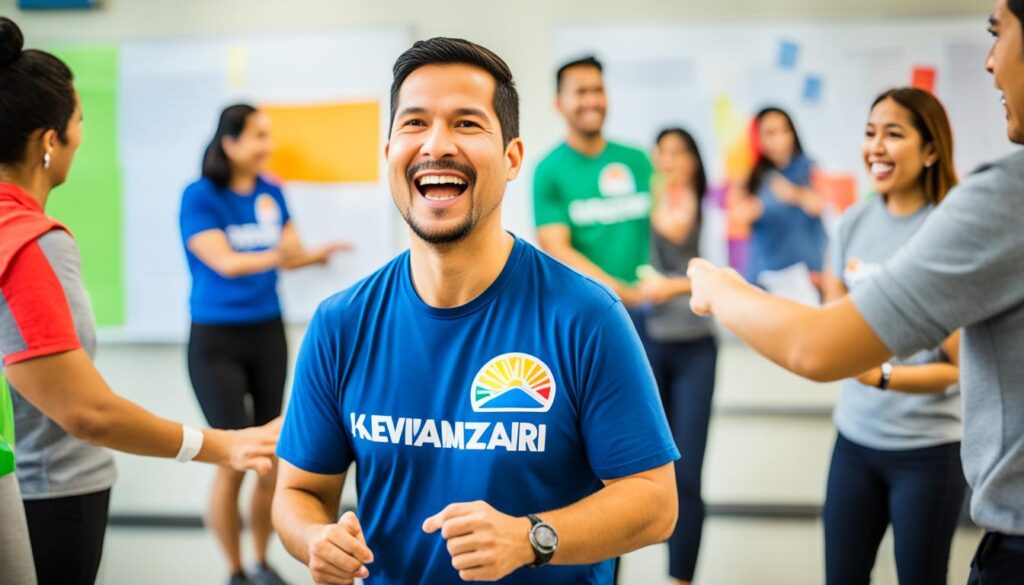Are you looking to enhance your leadership skills and drive success within your organization? Look no further than leadership training activities. These activities play a crucial role in developing the skills and competencies needed to become an effective leader. From team building exercises to professional development workshops, leadership training activities are a powerful tool for empowering teams and fostering growth.
In this article, we will explore the significance of leadership training activities and how they contribute to organizational success. We will delve into the role of leadership in team dynamics and the importance of investing in leadership development. Furthermore, we will discuss various leadership training activities that can identify and nurture potential leaders within your organization.
Join us on this journey as we unlock the secrets to mastering diverse leadership styles, fostering trust and support within teams, enhancing communication, and igniting innovation. Get ready to empower your team and drive organizational growth with the power of leadership training activities.

Key Takeaways:
- Leadership training activities are essential for developing effective leaders.
- Investing in leadership development contributes to organizational success.
- Team building exercises and professional development workshops are crucial components of leadership training activities.
- Leadership training activities help identify and nurture potential leaders within an organization.
- Diverse leadership styles, trust-building, communication enhancement, and innovation are key areas covered in leadership training activities.
The Significance of Leadership Training Activities
Effective leadership is crucial for fostering a positive work environment, improving team communication, and achieving organizational goals. Leadership training activities play a vital role in developing the necessary skills and competencies for individuals to become effective leaders. These activities provide opportunities for individuals to enhance their leadership role within teams and organizations, leading to improved team dynamics and overall performance.
Understanding the Role of Leadership in Team Dynamics
Leadership plays a critical role in shaping team dynamics. It involves guiding and coordinating individuals towards a common goal, promoting collaboration, and maximizing the potential of each team member. Effective leaders ensure that team members are motivated, engaged, and encouraged to contribute their unique skills and perspectives. They foster an environment of trust, open communication, and mutual respect, which leads to increased productivity and innovation.
Leadership training activities offer individuals the opportunity to develop a deep understanding of the role of leadership in team dynamics. Through interactive exercises, workshops, and seminars, participants can enhance their leadership skills and learn effective strategies for managing conflicts, facilitating decision-making processes, and inspiring and motivating teams.
Investing in Leadership Development for Organizational Success
Organizational success heavily relies on effective leadership. Investing in leadership development activities is crucial for nurturing a pipeline of competent leaders who can drive growth and excellence within the organization. Leadership training activities provide individuals with the tools, knowledge, and experiences necessary to succeed in leadership roles.
By investing in leadership development, organizations can build a strong leadership bench, ensuring a smooth transition in roles and continuity of operations even during times of change. Effective leaders contribute to the development of a high-performance culture, attracting top talent and retaining skilled employees. They also foster a positive work climate, where individuals feel valued, motivated, and supported in their professional growth.
Leadership training activities are not only beneficial for individuals seeking to enhance their leadership skills but also crucial for organizations striving for long-term success. By investing in leadership development, organizations can unlock the full potential of their teams, improve team dynamics, and create a culture of excellence and innovation. Ultimately, a strong leadership foundation is the key to achieving organizational success in today’s competitive business landscape.
Identifying Potential Through Leadership Development Activities
Leadership development activities are essential for identifying and nurturing potential leaders within an organization. By providing employees with opportunities to enhance their leadership skills, businesses can cultivate a pool of talented individuals who can contribute to the company’s growth and success.
One of the key benefits of leadership development activities is their ability to create a positive work climate. When employees are given the chance to develop their leadership abilities, it fosters a sense of empowerment and engagement. This, in turn, leads to a more positive and supportive work environment, where team members feel motivated and valued. A positive work climate promotes stronger collaboration, open communication, and a shared commitment to achieving common goals.
Team building exercises play a pivotal role in leadership development activities. These activities allow employees to collaborate, communicate, and problem-solve together, fostering teamwork and trust. Team building exercises not only strengthen interpersonal relationships but also promote a sense of camaraderie and unity among team members. By participating in these exercises, individuals can develop essential leadership skills such as effective communication, conflict resolution, and decision-making.
One effective team building exercise is the “Trust Fall,” where participants take turns falling backward, trusting their teammates to catch them. This exercise not only builds trust among team members but also allows individuals to develop courage, vulnerability, and strong communication skills. Another popular team building exercise is the “Minefield” game, where participants have to navigate through a designated area blindfolded, relying on their teammates’ instructions. This game enhances trust, communication, and problem-solving abilities.
In conclusion, leadership development activities play a crucial role in identifying and nurturing potential leaders within organizations. These activities contribute to the creation of a positive work climate and foster strong team dynamics. Through team building exercises, employees develop essential leadership skills while building trust and collaboration. By investing in leadership development activities, businesses can unlock the full potential of their employees and drive organizational success.

Leadership Skills Training Through Interactive Exercises
Effective leadership requires a combination of various skills, including strong communication, strategic thinking, and problem-solving abilities. In this section, we will explore how leadership skills training can be enhanced through interactive exercises. These exercises provide hands-on experiences that help leaders develop their skills in a practical and engaging way.
One of the key aspects of leadership is effective communication. By participating in structured workshops, leaders can learn how to communicate more effectively with their team members. These workshops provide opportunities to practice active listening, articulating ideas clearly, and conveying information in a way that is easily understandable to others. By honing their communication skills, leaders can foster better collaboration and create a more productive work environment.
| Interactive Exercises for Leadership Skills Training | Benefits |
|---|---|
| Role-play simulations | Improves interpersonal skills and conflict resolution abilities |
| Group problem-solving challenges | Enhances critical thinking and decision-making skills |
| Team-building activities | Fosters collaboration and strengthens relationships among team members |
Strategic planning and problem-solving are also vital components of effective leadership. Through engaging in problem-solving challenges, leaders can develop their ability to think analytically, foster creativity, and make strategic decisions. These challenges can simulate real-life scenarios and encourage leaders to devise innovative solutions to complex problems. By sharpening their problem-solving skills, leaders can navigate challenges more efficiently and guide their teams toward success.
Leadership skills training through interactive exercises not only equips leaders with the necessary tools for success but also fosters a collaborative and dynamic learning environment. By participating in hands-on activities, leaders can actively apply their newfound skills and knowledge in practical situations. This experiential learning approach enhances engagement and retention, ensuring that leaders are well-prepared to overcome challenges and inspire their teams towards greatness.
Building Cohesion with Leadership Team Building Activities
Fostering Trust and Support within Teams
Cohesion and trust are essential for high-performing teams. When team members trust and support one another, they are more likely to collaborate effectively and achieve shared goals. Leadership team building activities provide a valuable opportunity to foster trust and support within teams, creating a strong foundation for success.
One effective way to foster trust is through team-building exercises that encourage open communication and cooperation. These activities can include problem-solving challenges, group discussions, and collaborative projects. By participating in these activities, team members learn to rely on each other’s strengths and develop a sense of mutual trust.

Furthermore, leadership team building activities help break down barriers and create a more inclusive and supportive work environment. They provide an opportunity for team members to interact outside of their usual work tasks, building personal connections and camaraderie. This can significantly improve team dynamics and foster a sense of unity and cohesion among team members.
Encouraging Team Bonding through Creative Exercises
In addition to trust-building activities, incorporating creative exercises into leadership team building activities can greatly enhance team bonding. Creative exercises allow team members to engage in shared experiences that promote collaboration and creative thinking.
These exercises can take various forms, such as art-based activities, improvisation games, or problem-solving challenges. By engaging in these activities, team members not only bond with one another but also develop their creativity and problem-solving skills.
Creative team building exercises also provide a relaxed and fun environment that encourages team members to let their guard down and express themselves freely. This can create a positive and enjoyable atmosphere within the team, further strengthening their bond.
Examples of Leadership Team Building Activities
| Activity | Description |
|---|---|
| Escape Room Challenge | Teams work together to solve puzzles and escape a themed room within a time limit, promoting teamwork and problem-solving skills. |
| Outdoor Adventure Activities | Engaging in outdoor activities like hiking, rock climbing, or team building games in a natural environment, fostering teamwork, resilience, and communication. |
| Team Cooking Class | Teams learn to cook a meal together under the guidance of a professional chef, promoting collaboration, communication, and creativity. |
| Team Building Workshops | Participating in interactive workshops that focus on specific team-building skills, such as communication, trust-building, and conflict resolution. |
These examples are just a few of the many leadership team building activities that organizations can implement to foster trust, team bonding, and creativity among their teams. By investing in these activities, leaders can create a positive and cohesive team culture, leading to increased productivity and overall success.
Mastering Diverse Leadership Styles for Organizational Growth
Effective leadership is not a one-size-fits-all approach. Every leader has their own unique leadership style that they bring to the table. In order to promote organizational growth, it is essential for leaders to master diverse leadership styles that can adapt to different situations and challenges.
Exploring Adaptive Leadership Techniques
Adaptive leadership techniques play a crucial role in navigating the rapidly changing business landscape. Leaders need to be able to adapt their approach and strategies to address the diverse needs of their teams and organizations.
By embracing adaptive leadership techniques, leaders can effectively respond to unforeseen challenges, inspire innovation, and drive organizational growth. These techniques empower leaders to think creatively, foster collaboration, and motivate their teams to achieve outstanding results.
Reflection and Analysis in Leadership Training
Reflection and analysis are key components of leadership training that can significantly enhance a leader’s effectiveness. Leaders who take the time to reflect on their experiences and analyze their actions can gain valuable insights and make informed decisions.
During leadership training, leaders are encouraged to reflect on their strengths, weaknesses, and areas for improvement. Through self-reflection and analysis, leaders can identify patterns, gain self-awareness, and discover new strategies for growth.
Furthermore, reflection and analysis provide leaders with the opportunity to assess their decision-making processes and develop a deeper understanding of the impact of their actions on their teams and organizations.
| Benefits of Mastering Diverse Leadership Styles | How Adaptive Leadership Techniques Drive Growth | The Importance of Reflection and Analysis |
|---|---|---|
| 1. Enhances team collaboration and creativity | 1. Enables leaders to respond to changing market conditions | 1. Facilitates self-awareness and personal growth |
| 2. Fosters inclusivity and diversity in decision-making | 2. Inspires innovation and breakthrough thinking | 2. Improves decision-making and problem-solving skills |
| 3. Builds stronger relationships with team members | 3. Motivates and engages employees for improved performance | 3. Drives continuous improvement and learning |
By mastering diverse leadership styles, exploring adaptive leadership techniques, and embracing reflection and analysis, leaders can propel their teams and organizations towards growth and success.
Leadership Training Activities for Personal Leadership Growth
Continuous personal leadership growth is essential for becoming an effective leader. By investing in leadership training activities that focus on self-awareness and personal development, individuals can cultivate the skills and qualities needed to lead with confidence and influence. In this section, we will explore the importance of self-awareness in leadership and how self-assessment tools can facilitate this process. We will also discuss the feedback mechanisms that play a crucial role in fostering personal growth and enhancing leadership skills.
Cultivating Self-awareness with Self-assessment Tools
Self-awareness is a fundamental aspect of personal leadership growth. It involves understanding one’s strengths, weaknesses, values, and beliefs, as well as how these aspects influence behavior and decision-making. Self-assessment tools provide individuals with valuable insights into their unique leadership styles, preferences, and areas for improvement.
Through self-assessment exercises, leaders can gain a deeper understanding of their leadership approach, communication style, and problem-solving strategies. These tools allow individuals to reflect on their leadership capabilities, identify areas that require development, and create actionable plans for growth. By embracing self-awareness, leaders can effectively navigate challenges, adapt their leadership styles, and inspire their teams to achieve outstanding results.

Feedback Mechanisms to Foster Personal Development
Feedback is a powerful tool for personal development. Through feedback, leaders can receive valuable insights, perspectives, and constructive criticism that can help them enhance their leadership approach. Leadership training activities incorporate feedback mechanisms to provide leaders with a well-rounded perspective on their strengths and areas for growth.
Feedback can be obtained through various channels, such as one-on-one coaching sessions, performance evaluations, and peer-to-peer evaluations. These mechanisms promote open communication, encourage learning from mistakes, and foster a culture of continuous improvement within the organization. By actively seeking and embracing feedback, leaders can refine their leadership skills, build stronger relationships with their teams, and drive personal and professional growth.
Whether through self-assessment tools or feedback mechanisms, leadership training activities that prioritize personal development and self-awareness contribute to the overall growth and effectiveness of leaders. By investing in these activities, individuals can unlock their leadership potential, inspire others, and create positive and lasting impact within their organizations.
The Art of Delegation in Leadership Training
Delegation is a crucial skill for effective leadership. It involves assigning tasks and responsibilities to team members based on their strengths and abilities, while trusting them to complete the work successfully. In leadership training, the art of delegation is taught and practiced to empower team members and promote their growth.
Empowering Team Members Through Delegation Exercises
Delegation exercises are designed to provide team members with opportunities to take on new responsibilities and expand their skill sets. These exercises allow team members to step outside of their comfort zones and develop their problem-solving abilities, decision-making skills, and accountability. By delegating tasks to team members, leaders not only alleviate their own workload but also instill a sense of ownership and confidence in their team.
During delegation exercises, team members are given the freedom to make decisions and take the lead on specific projects. This autonomy is essential for empowering team members and fostering their professional growth. By delegating tasks, leaders demonstrate their trust in their team’s capabilities and encourage them to take ownership of their work.
Delegation exercises can take various forms, such as assigning team members to lead projects, allowing them to oversee specific tasks from start to finish, and encouraging them to collaborate with their peers. These exercises provide valuable learning experiences and help team members develop their leadership skills.
Leadership training programs often incorporate delegation exercises to give team members a practical understanding of how delegation works and its positive impact on team dynamics. These exercises simulate real-life scenarios and allow team members to experience the challenges and rewards of delegation firsthand.
Role Reversal Scenarios to Build Leadership Confidence
In addition to delegation exercises, role reversal scenarios are another effective strategy used in leadership training to build leadership confidence. These scenarios involve team members temporarily stepping into leadership roles, allowing them to gain a different perspective and develop empathy for their leaders.
Role reversal scenarios can be structured in various ways. For example, team members can be paired with each other on a rotational basis to act as leaders for a specific project or task. This gives them the opportunity to experience the responsibilities and challenges that leaders face, such as making decisions, managing conflicts, and motivating team members.
By participating in role reversal scenarios, team members gain a deeper understanding of the leadership role and develop respect and appreciation for their leaders. This experience enhances their overall leadership skills and encourages collaboration and empathy within the team.
Image for Illustration: The Art of Delegation
| Benefits of Delegation | Tips for Effective Delegation |
|---|---|
| 1. Empowers team members to take ownership of their work and develop valuable skills. | 1. Clearly communicate expectations and goals when delegating tasks. |
| 2. Promotes collaboration and fosters a sense of trust and accountability within the team. | 2. Select the right team members for the delegated tasks, based on their skills and interests. |
| 3. Increases efficiency and productivity by distributing workload effectively. | 3. Provide support and guidance to team members during the delegation process. |
| 4. Allows leaders to focus on strategic and high-priority tasks. | 4. Encourage open communication and regular feedback between leaders and team members. |
Creative Leadership Games to Ignite Innovation
Creativity and innovation are key drivers of organizational growth. To foster these essential qualities within teams, leaders can incorporate creative leadership games into their training programs. These games provide a fun and interactive way to encourage idea generation, innovative thinking, and problem-solving skills. By incorporating gamified elements into leadership training, team members are more likely to engage actively and think outside the box.
Leadership Idea Generation and Innovative Thinking
Idea generation is a critical component of innovation. To stimulate creative thinking, leaders can organize brainstorming sessions where team members are encouraged to share their ideas freely. Additionally, creative leadership games like “Rapid Ideation” or “Reverse Thinking” can challenge individuals to approach problems from different angles, leading to unique and innovative solutions. By creating a supportive environment that values diverse perspectives and encourages risk-taking, leaders can foster a culture of innovative thinking.
Applying Improvisation to Leadership Scenarios
Improvisation exercises can be highly effective in developing leadership skills and nurturing creativity. Through activities like “Yes, And…” or “Impromptu Presentations,” leaders can enhance their ability to think on their feet, adapt to unexpected situations, and encourage innovative problem-solving. These exercises promote a mindset of agility, innovation, and open-mindedness, empowering leaders to navigate complex leadership scenarios with confidence and creativity.
Incorporating creative leadership games and fostering innovative thinking are essential for igniting innovation within teams. These activities provide an interactive and engaging approach to developing leadership skills and fostering a culture of creativity and innovation. By embracing these strategies, leaders can empower their teams to excel and drive organizational growth.
Inspiring Transformation with Team Bonding Activities
Building a strong and cohesive team requires effective team bonding activities. These activities inspire transformation within teams and foster a sense of unity, collaboration, and enhanced teamwork. By engaging in team bonding activities, team members can develop stronger relationships, improve communication, and work together more effectively towards common goals.
Collaborative projects are an excellent way to enhance teamwork within a team. These projects encourage team members to work together, share ideas, and leverage their collective skills and knowledge. By collaborating on projects, team members can gain a deeper understanding of each other’s strengths, build trust, and improve problem-solving abilities.
Leadership activities also play a crucial role in strengthening team unity. These activities allow team members to develop their leadership skills, foster a sense of responsibility, and build trust within the team. Through leadership activities, team members can learn to support and motivate each other, create a positive work environment, and enhance overall team performance.
Collaborative Projects for Enhanced Teamwork
Collaborative projects provide an opportunity for team members to work together towards a common objective. These projects can be small-scale tasks or larger initiatives that require the collective effort of the entire team. By working on collaborative projects, team members can:
- Share ideas and knowledge
- Pool resources and expertise
- Improve problem-solving skills
- Enhance communication and coordination
- Build trust and foster cooperation
Collaborative projects not only enhance teamwork but also promote creativity and innovation within the team. When team members collaborate, they can leverage each other’s strengths and viewpoints, leading to more impactful outcomes and creative solutions.
Leadership Activities that Strengthen Team Unity
Engaging in leadership activities can greatly contribute to team unity and overall team performance. These activities provide team members with opportunities to develop their leadership skills and build a cohesive and supportive team culture. Some examples of leadership activities that can strengthen team unity include:
- Team-building workshops
- Problem-solving challenges
- Role-playing exercises
- Team reflection and analysis sessions
- Mentoring and coaching programs
Through these activities, team members can develop a deeper understanding of their roles within the team, build trust and mutual respect, and enhance their ability to work collaboratively towards shared goals. Leadership activities not only strengthen team unity but also equip team members with valuable leadership skills that can benefit them in their professional development.
How Leadership Training Activities Shape Effective Managers
Leadership training activities are instrumental in shaping effective managers who can lead their teams to success. By providing individuals with the necessary skills and abilities, these activities contribute to the development of competent and confident leaders. Let’s explore how leadership training activities play a pivotal role in shaping managers who can inspire and guide their teams towards achieving organizational objectives.
Setting Clear Expectations for Team Success
One of the key factors that differentiate effective managers from the rest is their ability to set clear expectations for their teams. Leadership training activities help managers understand the importance of clearly communicating objectives, goals, and performance expectations, ensuring that everyone is aligned and working towards a common purpose. By setting clear expectations, managers empower their team members to perform at their best, enhance accountability, and drive overall team success.
Recognizing Achievements to Boost Morale
Recognition is a powerful motivator that can boost employee morale and productivity. Effective managers understand the significance of recognizing and appreciating the achievements of their team members. Leadership training activities provide managers with the knowledge and tools to implement effective recognition strategies, such as celebrating milestones, providing constructive feedback, and acknowledging individual and team accomplishments. By recognizing achievements, managers not only boost morale but also foster a positive work environment that encourages continuous growth and success.

| Benefits of Leadership Training Activities for Managers: |
|---|
| • Enhanced leadership skills and abilities |
| • Improved communication and team management |
| • Increased employee engagement and motivation |
| • Better decision-making and problem-solving capabilities |
| • Strengthened relationships with team members |
| • Empowered to guide and inspire teams towards success |
By participating in leadership training activities, managers can acquire valuable skills and knowledge that enable them to lead with confidence, develop high-performing teams, and drive organizational success. Through these activities, managers gain the ability to set clear expectations and recognize achievements, ultimately shaping them into effective leaders who can navigate the challenges of a dynamic work environment.
Conclusion
In conclusion, leadership training activities are invaluable in empowering teams and driving organizational success. The key takeaways from this article demonstrate the crucial role that leadership plays in team dynamics, organizational growth, and personal leadership development.
Investing in leadership training activities equips individuals with the skills and competencies necessary to effectively lead teams, enhance communication, and foster a positive work climate. By participating in team building exercises and interactive workshops, leaders can strengthen team cohesion, trust, and collaboration.
Furthermore, mastering diverse leadership styles and utilizing self-assessment tools promote continuous improvement and self-awareness among leaders. The art of delegation, combined with creative leadership games and activities, sparks innovation and ignites new perspectives.
By implementing leadership training activities, organizations in the Philippines can empower their teams to reach their full potential, achieve goals, and drive overall success.
FAQ
What is the role of leadership in team dynamics?
Leadership plays a crucial role in team dynamics by providing guidance, direction, and motivation to team members. It helps establish a positive work environment, improves communication, and enhances overall team performance.
Why is investing in leadership development important for organizational success?
Investing in leadership development activities is important for long-term organizational success because it helps identify and nurture potential leaders, improves leadership skills, and fosters growth within the organization. It ensures that the right leaders are in place to lead teams effectively.
What are some leadership training activities that promote a positive work climate?
Leadership training activities that promote a positive work climate include team building exercises, trust-building activities, and collaborative projects. These activities encourage teamwork, enhance communication, and create a supportive environment for team members.
How can structured workshops enhance communication among team members?
Structured workshops can enhance communication among team members by providing opportunities for open dialogue, active listening, and effective feedback. They create a safe space for team members to share ideas and opinions and help build strong communication skills.
How can leadership team building activities foster trust and support within teams?
Leadership team building activities can foster trust and support within teams by promoting collaboration, encouraging open communication, and building relationships. These activities create a sense of unity and camaraderie, which enhances teamwork and strengthens trust among team members.
Why is mastering diverse leadership styles important for organizational growth?
Mastering diverse leadership styles is important for organizational growth because it allows leaders to adapt to different situations and effectively lead diverse teams. It promotes innovation, encourages creativity, and fosters a culture of inclusion and collaboration.
How can leadership training activities cultivate self-awareness?
Leadership training activities can cultivate self-awareness by using self-assessment tools that help leaders understand their strengths, weaknesses, and leadership style. These activities encourage introspection and reflection, leading to personal growth and development.
What is the art of delegation in leadership training?
The art of delegation in leadership training is the ability to assign tasks and responsibilities to team members based on their skills and strengths. Effective delegation empowers team members, promotes their growth and development, and allows leaders to focus on strategic decision-making.
How can creative leadership games ignite innovation within teams?
Creative leadership games can ignite innovation within teams by promoting idea generation, encouraging flexible thinking, and fostering a creative mindset. These games challenge team members to think outside the box and come up with innovative solutions to problems.
What are some team bonding activities that inspire transformation?
Team bonding activities that inspire transformation include collaborative projects, team-building exercises, and leadership activities focused on strengthening team unity. These activities encourage trust, boost morale, and create an environment that nurtures personal and professional growth.
How do leadership training activities shape effective managers?
Leadership training activities shape effective managers by providing them with the necessary skills and abilities to lead teams successfully. These activities focus on setting clear expectations, developing effective communication skills, and recognizing and rewarding achievements to boost team morale.
Why is investing in leadership training activities important?
Investing in leadership training activities is crucial because it empowers teams, improves communication and teamwork, cultivates leadership skills, and drives organizational success. It helps organizations develop strong leaders who can navigate challenges and lead their teams towards achieving their goals.
